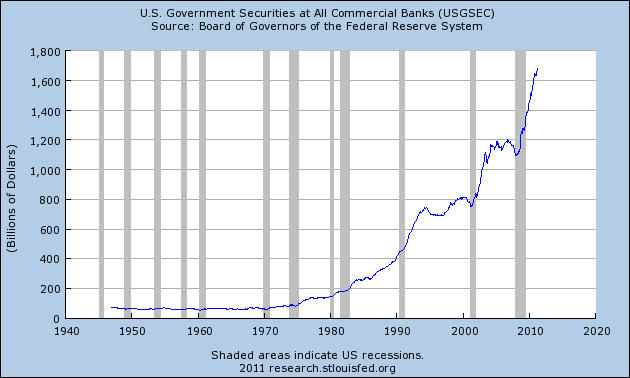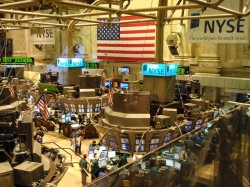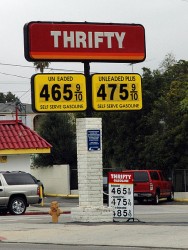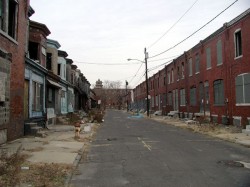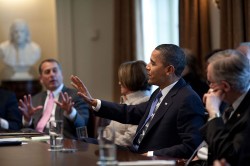 The entire U.S. financial system has become a gigantic shell game. While it is still in motion, a shell game can be mesmerizing to watch. But when it ends the consequences can be painful. So exactly what is a shell game? According to Wikipedia, a shell game “is portrayed as a gambling game, but in reality, when a wager for money is made, it is a confidence trick used to perpetrate fraud.” Sadly, that is exactly what is happening on the global stage today. The Federal Reserve is like a con artist that is desperately trying to stay one step ahead of everyone else. The folks at the Fed know that the debt that the U.S. government has accumulated is not sustainable and will eventually collapse. They also know that the U.S. dollar is eventually going to become essentially worthless. But for now the Federal Reserve is putting on a grand show and is trying to keep everyone believing that the game is fair and legitimate.
The entire U.S. financial system has become a gigantic shell game. While it is still in motion, a shell game can be mesmerizing to watch. But when it ends the consequences can be painful. So exactly what is a shell game? According to Wikipedia, a shell game “is portrayed as a gambling game, but in reality, when a wager for money is made, it is a confidence trick used to perpetrate fraud.” Sadly, that is exactly what is happening on the global stage today. The Federal Reserve is like a con artist that is desperately trying to stay one step ahead of everyone else. The folks at the Fed know that the debt that the U.S. government has accumulated is not sustainable and will eventually collapse. They also know that the U.S. dollar is eventually going to become essentially worthless. But for now the Federal Reserve is putting on a grand show and is trying to keep everyone believing that the game is fair and legitimate.
The Federal Reserve’s much ballyhooed “QE2” program has come to an end, and most Americans still don’t even understand what “quantitative easing” is.
Basically, what the Federal Reserve did was zap hundreds of billions of dollars into existence out of thin air and used them to buy U.S. government debt.
It is kind of like if you are playing poker with someone and they reach under the table and pull out a gigantic pile of chips which they add to their own stack.
In the process, the big banks made a ton of money because they are the ones that the Federal Reserve was buying U.S. Treasuries from and the U.S. government was happy because all of the new government debt being issued was getting soaked up by the system.
Of course all of this is one giant Ponzi scheme, but up to this point the Federal Reserve has gotten away with it.
Meanwhile, average Americans were getting the short end of the stick because all of this new money has been causing the price of food and the price of gas to go up.
But now QE2 has come to an end.
So does that mean that “quantitative easing” is going to be completely over?
No, not really. The shell game continues.
The Federal Reserve has announced that it is going to continue to purchase U.S. government debt using the proceeds from maturing debt that it already owns. It is being projected that the Federal Reserve will purchase 300 billion dollars in U.S. government debt over the next 12 months using this method.
This isn’t being called “quantitative easing”, but that is essentially what it is. In fact, one CNN article is calling it “QE2.5”….
QE2 is just about done. But the Federal Reserve will still be buying massive amounts of long-term Treasuries.
In fact, the Fed’s purchases over the next year will likely be at least $300 billion. That’s half the size of QE2 — even if QE3 never takes place.
But “quantitative easing” is just one example of a shell game run by the Fed. There have been lots more.
For example, during the financial crisis the Federal Reserve started loaning gigantic amounts of cash to the big banks for next to nothing.
The big banks took a lot of this cash and invested it in U.S. Treasuries. U.S. Treasuries typically only pay a couple of percentage points, but when you can borrow massive amounts of nearly free money suddenly they become extremely profitable.
Instead of loaning out large amounts of money to all of us to get the economy rolling again, the big banks just parked huge amounts of cash in U.S. Treasuries and watched the risk-free profits come rolling in.
In this way, the Federal Reserve helped big banks make a ton of money and they supported the exploding federal government debt load at the same time.
The chart below shows that the amount of U.S. government securities owned by the banks has increased exponentially since the beginning of the financial crisis. This is not an accident….
The Federal Reserve does lots of stuff like this. They know that they will probably never get audited and they know that the American people don’t understand all of this financial stuff, so they get away with it.
But what if something came along and suddenly interrupted the shell games that the Fed is playing?
Well, that is exactly what this debt ceiling debate threatens to do.
If the U.S. defaults, even for a short time, all of the financial shell games and Ponzi schemes are going to be greatly jeopardized.
If Congress does not raise the debt ceiling by August 2nd, the U.S. government will start defaulting, and that would unleash a tremendous amount of chaos.
A recent USA Today article described some of the things that might happen if the government was not able to borrow any more money later this summer….
If Social Security, Medicare, Medicaid, unemployment benefits, payments to defense contractors and interest payments on Treasury bonds were exempt, that would be all the government could afford for the month. No money for troops or veterans. No tax refunds. No food stamps or welfare. No federal salaries or benefits.
In addition, financial markets all over the world would be severely rattled. If the default only lasted a couple of days it would not be bad, but if the U.S. ended up defaulting on debts for weeks or months it really would be cataclysmic.
The International Monetary Fund warned this week that a failure to raise the debt ceiling by August 2nd would be a “severe shock” to global financial markets.
In this case, the IMF is actually right. In fact, a “severe shock” would be an understatement.
The managing director of Standard & Poor’s has told Reuters that if the U.S. starts defaulting, the credit rating on U.S. Treasury bonds that are supposed to mature on August 4th will go all the way down from AAA to D….
Chambers, who is also the chairman of S&P’s sovereign ratings committee, told Reuters on Tuesday that U.S. Treasury bills maturing on August 4 would be rated ‘D’ if the government fails to honor them. Unaffected Treasuries would be downgraded as well, but not as sharply, he said.
“If the U.S. government misses a payment, it goes to D,” Chambers said. “That would happen right after August 4, when the bills mature, because they don’t have a grace period.”
A lot of Americans believe that Congress should just refuse to raise the debt ceiling and let the whole system crash. But the reality is that most Americans simply have no idea how much of a financial disaster that would be for the entire globe.
Yes, the U.S. national debt is completely and totally out of control. Yes, something must be done about it urgently.
But defaulting on our debts and wrecking global financial markets is not going to solve much of anything.
Sadly, even if we do not default on our debts this year, the reality is that the U.S. government debt bubble is going to collapse one way or another eventually.
The path that we are currently on is not even close to sustainable.
Even as our debt expands exponentially, the U.S. economy is being systematically dismantled and we are becoming poorer as a nation.
As I have written about previously, jobs and businesses are leaving the United States at a staggering rate because of cheap labor overseas and because of ridiculous regulations. The business environment in this country has become incredibly toxic.
Stanford University’s David Cheriton was instrumental in helping Sergey Brin and Larry Brin develop Google. Now he is warning that the anti-business policies of Barack Obama and the U.S. Congress are wrecking the economy….
“When you look at, say, Larry and Sergey of Google, they made billions of dollars, but they contributed many more billions of dollars to the US economy. And so we should be empowering these people; we should be cultivating more of the next generation of those types. And yet, I think there’s almost a hostile attitude towards people who have been successful in this country.”
As I wrote about the other day, the rate of new business creation in the United States has been declining steadily since the 1980s. We won’t have a chance at a real economic recovery until the creation of small businesses is encouraged once again.
But today businesses of all sizes are trying to avoid U.S. taxation. Right now, the United States has the highest corporate tax rate in the entire world. Sadly, all businesses have a great deal of incentive to avoid incorporating in the United States.
A recent article in The Wall Street Journal talked about this phenomenon….
As savvy investors and entrepreneurs search for ways to minimize the impact of the U.S. tax system, with its relatively high rates and global reach, they are increasingly incorporating overseas, tax experts say. Some private-equity firms have relocated U.S. companies or divisions to tax-haven countries. U.S. multinational companies have spun off foreign subsidiaries in tax havens. U.S. start-ups are even beginning life offshore.
Large numbers of really good companies are fleeing the United States.
What we are doing is not working.
So what is the answer?
Well, as I have said before, we need to entirely scrap the current tax system and come up with something that works in the 21st century.
But we all know that is not going to happen.
Meanwhile, our economy continues to unravel. According to the Department of Labor, the unemployment rate rose in 210 metro areas during the month of May, and it only declined in 131 metro areas.
Consumer confidence in this country has hit a seven-month low, and average Americans are becoming increasingly anxious about the state of the economy.
Unfortunately, most of our politicians don’t seem to have any answers and the Federal Reserve is just trying to keep their shell games going.
Every single day the U.S. economy is getting weaker. Every single day we are going into more debt. Every single day we get closer to the collapse of the entire system.
Time is running out.
I hope you are making good use of the time you still have left.
